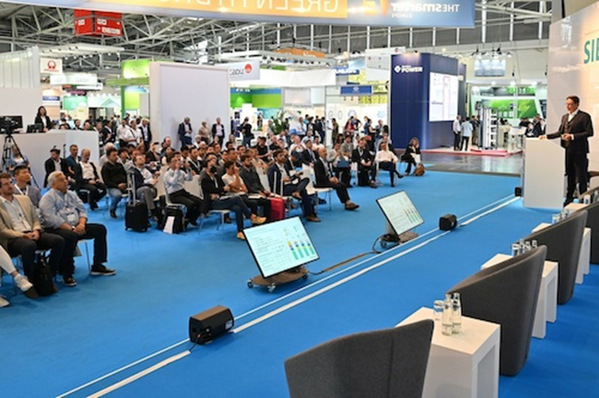The number of electric cars on the road is skyrocketing. According to Wood Mackenzie, around 280 million electric cars will have taken to the streets around the world by 2040 – a dramatic increase from just under six million at the end of 2018. What’s more, these cars and their batteries will take on more and more additional functions within our energy supply, made possible in part by falling prices. According to data provided by BloombergNEF, prices dropped from an average of $1,160/kWh to about $176/kWh between 2010 and 2018 alone. Analysts expect a further drop to $96/kWh by 2025, and $70/kWh by 2030 – a price reduction of 18 percent per year.
The range of charging systems is growing just as dynamically, from wall boxes to charging stations to high-speed charging solutions and charging points which are coupled with a cogeneration system such as the ones featured by WOLF Power Systems at the exhibition. Other highlights at the event included boosters for high-speed charging stations, new and aesthetically appealing carports, and scalable charging solutions – for everything from individual parking spaces to company parking lots or multi-story parking garages. This market development is also reflected in the current market overview from the Power2Drive Europe exhibition. The number of suppliers and the range of wall boxes, charging stations, carports and services relating to e-mobility has grown significantly in comparison to last year.
Mobile battery storage systems – electric vehicles take on a new role
At the opening of the Power2Drive Conference, CEO and founder of The Mobility House Thomas Raffainer presented the island of Porto Santo in the Portuguese archipelago of Madeira as an example of how to intelligently interlink e-mobility and energy supply. “Porto Santo is the first island in the world to be supplied with power from electric vehicles,” he says. Two hundred electric cars are currently connected to the island’s power grid via bidirectional charging points, intelligent charge management and an aggregation platform. The grid is primarily fed by a 2 MW photovoltaic installation and a 1.1 MW wind power site. The cars’ batteries complement stationary storage systems using second-life batteries (retired car batteries) to temporarily store excess energy and feed it back into the island’s grid according to demand (vehicle-to-grid).
Hot topics and exciting events in the accompanying program
Other exciting conference topics included technology and trends surrounding charging infrastructure in Europe, fleet management for electric vehicles, and efficient and user-friendly billing systems for charging electric cars, just to name a few. The issue of calibration law and charging solutions which comply with this law also had everyone at the exhibition talking. Meanwhile, companies such as ebee smart technologies and has-to-be presented impressive solutions which they say are market-ready now. Martin Gamlich of Schneider Electric sums up his experience positively: “Our expectations have been exceeded. We took part in many great discussions and presented our integrated solutions and our portfolio to both a German and an international audience.”
New ideas for drive systems
Many new drive system solutions were also exhibited at Power2Drive Europe. “We presented our innovative products and solutions surrounding power meters and data acquisition systems for electric vehicle drives at Power2Drive for the first time. With crowds of international visitors and exhibitors flocking to Power2Drive, it served as the perfect platform for discussing present challenges and solutions – for instance as part of an exhibitor forum. Our highlight at this year’s event was an innovative power analyzer – a power meter for developing electric components, drivetrains or whole cars,” shared Christoph Wiedner, Chief Product Officer at DEWETRON.

Electric drives can be installed in increasingly diverse types of vehicles, be they passenger cars, commercial vehicles, light vehicles, ships or air taxis. Everyone is turning to electrical power. E-Force One has introduced a particularly innovative approach, not just offering fully electric commercial vehicles and buses for urban and trans-regional land transportation, but also retrofitting used trucks with electric motors. Managing Director at Haller GmbH & CO. KG, Andreas Haller, is proud of the 40-ton electric truck which the company brought to the exhibition. “Many visitors didn’t even know that such large electric vehicles exist, or that we re-engineer used trucks to fit them with electric motors. We have welcomed a lot of visitors, we’re doing great business and we’re thrilled to have been part of Power2Drive Europe.”
Nicolai Woyczechowski, Director of Sales for Germany, Austria and Switzerland at Virta, also stresses that, “as a provider of charging solutions for electric vehicles, we offer a platform for bridging the gap between the energy grid and e-mobility. We find it quite exciting to see how these industries are merging together and synergizing to use energy more intelligently, as evidenced here in Munich at Power2Drive and its three sister exhibitions.” (HCN)
Stay informed, get our free newsletter twice a week. Register here







